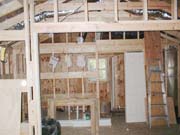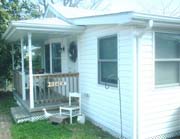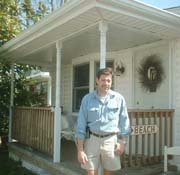|
|||
Buy at Auction; Remodel at LeisureHow I discovered the many ways a small house can go wrong
|
Step-by-Step Guide to Buying Foreclosed Property• To locate foreclosed properties, look through the Legal Notices of your local newspaper. Check the address against the county tax records online to get an idea of the property’s worth. • Check the auctioneer’s website the day of the auction. Home sales are often canceled; the most up-to-date information is available on-line. • Don’t expect to see the inside. People going through foreclosure rarely welcome a buyer. • If you bid on a home, have either cash or a cashier’s check for a down payment. Have the cashier’s check made out to yourself so it can be returned to your account if you don’t win the bid. • Decide on a specific amount that you’re willing to bid and don’t exceed it, no matter how cute or perfect the house appears. • Whatever your estimate is for the cost of repairs or renovation, add at least another $20,000. • Have licensed contractors perform the electrical work and plumbing. They know the current building codes and, in the long run, save you money. • Obtain the proper county or city permits and have the home inspected at every step. It would be difficult to sell later without permits and completed inspection stickers in hand. • If you rent a house in Maryland built before 1950, it has to be registered with the state and certified as lead free. That requires a licensed inspector testing the house for any lead paint, and, of course, it costs yet more money. • Finally, when removing shelving, do not continue if you hear a thump after each hammer blow. If you do find a box of live ammunition, turn it over to your local police department. –Allen Delaney |
Out on the Door Step
First to come was the eviction.
It would be between me and the former owner, the lawyer said, as to when he and his family must move. Performing an eviction was not a job I’d imagined.
Thanksgiving and Christmas were right around the corner when I called. When a man answered, I introduced myself as, well, the owner of his house. He told me that he had already made preparations to move and that I could drop by on Saturday and get the keys. That went better than I expected.
True to his word, the former owner, a lanky man in his early 30s, met me in front of the cottage the following Saturday morning with keys in hand. After he handed them over, he showed me how to unlock the front door if I ever got locked out. He did that by opening the front window from the outside and reaching around to unlock the front door. “The window lock is broken,” he explained.
Then he wished me luck, climbed into his pickup truck and drove away, leaving me standing on the front stoop peering into a home I had seen only from the outside.
Did I mention that foreclosure notices advertise that the homes are bought “as is”? That should have been a clue.
Stepping Inside
I stepped into a tiny living room scattered with bits of paper, trash and broken toys. The ceiling was about three inches above my six-foot frame. The wall-to-wall carpeting was worn beyond cleaning. In the far back corner was the remnant of an inexpensive entertainment center. From the looks of the place, the entertainment must have been professional wrestling.
The adjoining kitchen was tolerable, except for the torn and faded wallpaper. A small bedroom to the right of the front door, a step down from the living room, looked as if it had been remodeled from a side porch before the dawn of blueprints.
The bathroom, behind the kitchen, had a whirlpool tub in desperate need of sandblasting. In this room, the stacked washer-dryer and 50-gallon hot-water heater also resided.
The master bedroom, to the right of the kitchen, featured two plastic lawn bags filled with trash sitting on wall-to-wall carpet that, I was willing to bet, had never met a vacuum cleaner. In this room’s left rear corner, next to the entrance, was a small, open, parallelogram-shaped closet with several wooden shelves tacked up at various angles.
The windows throughout the house were the old wooden, single pane, double-hung type with cord and pulley counter-weights that assisted in their raising and lowering. I could almost taste the lead dust as I stared at them.
I searched for a back door to escape through, but there wasn’t one.
Stuck with a home that cave dwellers would turn down, I knew there was only one thing to do. But I didn’t have a box of matches, so I rolled up my sleeves, tightened my belt and headed out for a beer. I had to think.
This renovation would require much more than the few weekend improvements I’d anticipated. I had a full-time job; the renovation would take five years of Sundays. No, I had to hire a builder.
I was glad I still had the phone number of the builder who added an addition to my home eight years earlier. He did quality work and arrived on time. I gave Lee White a call, and he agreed to meet me at my new house the following weekend.
Calling for Help
On Saturday, I found a middle aged, stocky fellow with thick salt-and-pepper hair standing along the west side of my shack, eyeballing the siding. He took the last drag of his cigarette, smiled and shook his head as he walked toward me.
“That siding will have to go,” he said as he stuck out his hand.
After an hour of poking, pushing, tapping and eyeing my place, he told me what I had feared: total gut job. The walls would have to come down so he could examine the beams and upgrade the wiring. The roof would need replacing, along with the windows. Who knew what would be discovered once the siding came off.
We agreed that he would be paid by the hour since there was no way to determine an estimate of the job until everything was exposed. I gave him the first of many checks so he could get started in January.
During the next months, I worked each weekend, removing rugs, debris, and old appliances. I cleaned the yard of leaves and overgrown weeds and removed a picket fence that looked like a hockey player’s smile.
One morning I took on the closet shelving. The previous owner had had a nail gun and had used every nail in his arsenal to attach the top shelf. Mostly hidden by the closet frame, the shelf extended back into the wall. I hammered away from the underside to loosen the 7.3 million nails holding the stubborn board in place.
With each swing of the hammer, I heard something bounce on the shelf. My hand was too large to wriggle into the tiny space between the shelf and the closet frame to grab whatever it was. Once again I swung, and once again a thump followed. With each thump, I heard metal hit metal, as if a box of washers were being dropped from a height. Still, the shelf refused to give up its hold on the wall.
I considered alternative ways to attack the problem. I could possibly pry it out with a crowbar, or remove the closet frame or come in from the back of the closet, except that approach meant moving the washing machine. So I did what most men would do in this situation; I got a bigger hammer.
After nine or 10 good whops with a sledgehammer, each one followed by a louder thump, the shelf finally released its grip and crashed to the floor — along with the mystery object. Lying next to the nail-impaled shelf was a box of .45 caliber bullets. I stared at the open box of shells with their little primers staring back and decided it was time for a beer. Maybe five or six beers.
Diagnosis
January roared in with Lee close behind. The month turned out bitter cold, making life miserable for my builder and his partner. Despite the weather, inside walls came down and rotten beams were exposed. Floors were torn up and rotten joists came to light. Ancient cloth covered wiring, which I believe was once used by Thomas Edison, was torn out and old insulation removed.
The ceiling was taken down, exposing a second ceiling. The original so-called ceiling was a gray insulation board attached to 2x4s strung across the living room. The second ceiling was nailed to the first to hide its cheery gray color. Some of the 2x4s holding this mess up weren’t long enough for the length of the room, so they had been nailed together. That explained the rises and sags along the second ceiling.
Finally, when the weather was tolerable, the dark blue siding came down. That was when I learned the extent of what was to come.
“It’s not as bad as it looks,” Lee said. “The lower halves of some outside walls need replacing. They’re rotten from water seeping up into them from the ground.”
“Is that all?” I asked, already knowing the answer.
“Well, I think the bathtub has a leak. The outside bathroom wall is also rotten.”
Sure enough, once the wooden skirt was removed from the whirlpool tub, a rotting floor, sub-floor and wall beams were exposed. I reached for my checkbook. Again.
Every contractor who worked on the house asked the same question: “Why not just tear it down?”
My answer: “I can’t afford to build new.”
That was only partially true. Bit by bit, North Beach’s past is being erased as new three-story homes replace old cottages. I wanted to keep one of the original homes as best I could. Ten years from now, it may be the last one standing.
This Old House
Stripped, the original structure revealed itself.
Tax records say the house was built in 1940, but Lee and I surmised it was built earlier, before building codes and indoor plumbing were important.
The original house was a plain, square, box frame with tongue-and-groove wainscoting on the outside walls. Since the inside of the outside walls and the underside of the roof were painted yellow, we deduced that it was once an un-insulated summer cottage.
The rear bedroom, porch (become a second small bedroom) and bathroom had been added over the years.
From youthful visits to North Beach, Lee’s mother could remember Honey Pot trucks that came around and sucked out the outhouses.
North Beach would have been today’s equivalent of Ocean City. The cottage was probably used only as a place to sleep once the day’s festivities ended. I could imagine a family riding the train along the Chesapeake Bay Railway on a hot summer day to escape Washington’s humidity. I saw them using the little house to store their cots and blankets while they played at the amusement park that once resided along the boardwalk.
Little by little, the tiny house came back to life. The chimney was removed and all new wiring was installed along with a HVAC system replacing window air conditioners and space heaters.
The ceiling was raised, following the outline of the roof, to create a vaulted effect. Floors were insulated and carpeted, and old roof shingles were replaced with new. Kitchen cabinets with glass fronts were hung to give the area an open appearance, and all new appliances were installed.
As a nod to the home’s past, we made a period bathroom resembling one from the 1920s, complete with claw foot tub and wrap-around shower curtain.
In the living room, a new bay window looks out onto a new front porch.
After 18 months, the renovation was complete.
I found a renter, but I wasn’t thrilled about someone else living in the house I had resuscitated. I think of it as my little place near the Bay where I can retire some day if I choose.
As for total cost, let’s just say I could have purchased a new BMW Z8. But the house gets better mileage.
About the AuthorMaryland native and newlywed Allen Delaney moved to Prince Frederick in 1994 to be close to the Bay and the beloved blue crab. He works so he can fish and crab, and when the weather turns cold, he writes for enjoyment. This is his first feature, but his comic reflections have tickled Bay Weekly readers since the turn of the millennium. |
|



